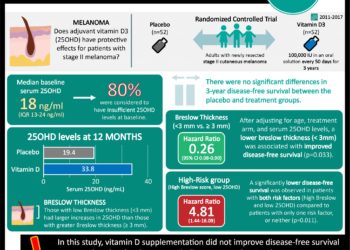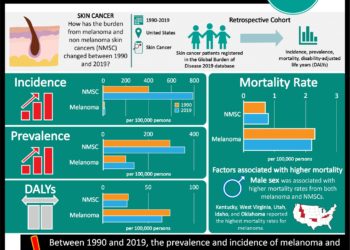Melanoma immunohistochemical analysis useful to determine BRAFV600E mutation status
1. The sensitivity and specificity for VE1 immunohistochemical analysis of BRAFV600E mutations in primary and cutaneous malignant melanomas were 96.7% and 94.5%, respectively.
Evidence Rating Level: 2 (Good)
Study Rundown: Cutaneous malignant melanoma (CMM) is a deadly form of skin cancer. One of the common mutations in superficial spreading melanoma, a subtype of CMM, is the BRAFV600E mutation, which is a target for pharmaceutical therapies. Currently, BRAF mutation status is determined via DNA tests. Immunohistochemical assays are an alternative that could identify the BRAFV600E mutation using the mutation specific VE1 antibody. These assays are less expensive, require less tissue, are more efficient, and are thought to be more sensitive. This study tested the use of VE1 immunohistochemical analysis on CMMs of various subtypes to better characterize BRAFV600E expression. Authors found a high sensitivity and specificity using this modality to determine BRAFV600E mutation status. The strength of the study was the large sample size; however, the study may have been limited as the CMM tumor samples were prepared by a variety of pathology labs, which may have caused variability in the results.
Click to read the study in JAMA Dermatology
Relevant Reading: Signaling Networks in Cutaneous Melanoma Metastasis Identified by Complementary DNA Microarrays
In-Depth [retrospective cohort]: One hundred twenty-four primary tumors and 76 associated metastases demonstrated the BRAFV600E mutation, which was confirmed via DNA mutation analysis. VE1 immunohistochemical analysis was subsequently performed for comparison on the same tumors. The samples consisted predominantly of acral lentiginous melanoma and superficial spreading melanoma (42.7% and 36.3%, respectively). Of all tumors, 63 (46.7%) stained positive for VE1 antibody. Most of these had moderate to strong VE1 staining, however 21 of the VE1 positive tumors stained weakly. Generally, the VE1 staining was homogenous. However in 46.7% of the positively staining tumors, the staining intensity was not equal between primary tumors and corresponding metastases, as the latter stained more weakly. Of this group, only 4 had corresponding differences in mutational status based on DNA analysis. In the full sample, there were 12 tumors that had discordant findings when compared to DNA mutation analysis.
More from this author: More from this author: Tech-aided surveillance of patients at high risk for melanoma aids early diagnosis, Indoor tanning linked to high skin cancer risk in US and abroad, Free drug samples may alter prescription habits of dermatologists, Atopic dermatitis may be more persistent than previously understood
Image: PD/CDC
©2015 2 Minute Medicine, Inc. All rights reserved. No works may be reproduced without expressed written consent from 2 Minute Medicine, Inc. No article should be construed as medical advice and is not intended as such by the authors, editors, staff or by 2 Minute Medicine, Inc.





